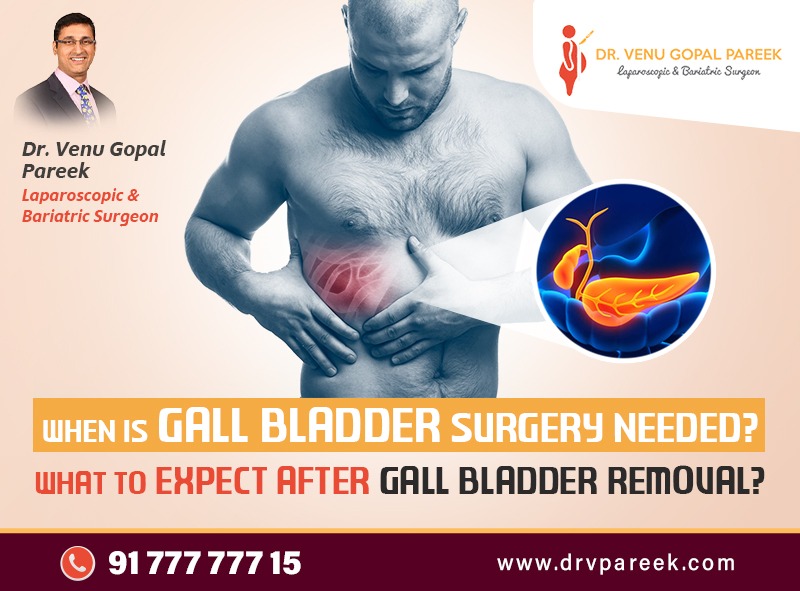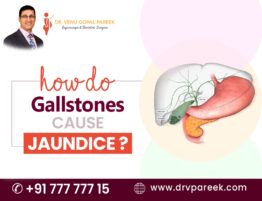
The gallbladder is a small organ that is located just below the liver on the upper right side of your abdomen. It is used to store bile which is a fluid produced by the liver and released into the small intestine to help digestion. The main function of bile is that helps to break down fats, proteins, and carbohydrates. A variety of conditions such as gallstones or infections affect the gallbladder and can become inflamed and painful.
Gallbladder Problems
The following are the gallbladder problems which may require surgery in severe cases.
Gallstones: Gallstones form when bile in the gallbladder becomes concentrated and forms hard pebble-like deposits. Gallbladder is a small organ located on the right side of the abdomen. They are made of cholesterol, bile salts, and other substances found in bile. Symptoms of gallstones may include abdominal pain, nausea, vomiting, and indigestion. Surgery may be necessary to remove the gallstones if they are causing pain or other symptoms.
Inflammation of the Gallbladder (Cholecystitis): Cholecystitis is an inflammation of the gallbladder that can be caused by infection or the presence of gallstones. Surgery may be necessary if the condition does not improve with medications or if there is a risk of rupture.
Gallbladder Cancer: Gallbladder cancer is a rare form of cancer and is often diagnosed at an advanced stage, making it difficult to treat. Surgery is the most common treatment for gallbladder cancer and is usually recommended if the cancer is localized and has not spread beyond the gallbladder. Depending on the extent of the cancer, the surgery may involve removing the entire gallbladder, nearby lymph nodes, and sometimes other organs and tissues. In some cases, chemotherapy or radiation therapy may be used in combination with surgery.
Gallbladder Polyps: These are small growths that can form in the gallbladder. If they are large enough, they can block the cystic ducts and lead to pain or other symptoms. In some cases, polyps need to be surgically removed.
The types of gallbladder surgery performed to treat gallbladder problems include:
Laparoscopic cholecystectomy: This is a minimally invasive surgical procedure to remove the gallbladder. A laparoscope (a thin tube with a camera on the end) is inserted through a small incision in the abdomen. The surgeon can then view the gallbladder on a video monitor and remove it using special instruments.
Open cholecystectomy: This is a traditional surgical procedure where a larger incision is made in the abdomen to access the gallbladder. The surgeon then removes the gallbladder through this incision.
Laparoscopic common bile duct exploration: This is a minimally invasive surgical procedure to identify and treat problems in the bile ducts. A laparoscope is inserted through a small incision and the surgeon can then view the bile ducts on a video monitor and take any necessary action.
Open common bile duct exploration: This is a traditional surgical procedure where a larger incision is made in the abdomen to access the bile ducts. The surgeon can then inspect and take action on any abnormalities visible.
Endoscopic retrograde cholangiopancreatography (ERCP) This is a procedure that uses an endoscope (a thin tube with a camera on the end) to examine the bile ducts. A dye is injected into the bile ducts to make them visible on x-rays, and a special instrument can be used to remove any blockages.
When is gallbladder surgery needed?
Gallbladder surgery, also known as a cholecystectomy, is typically necessary when a person is experiencing gallstones or chronic gallbladder inflammation. Some of the common symptoms of gallbladder disease include abdominal pain, nausea, vomiting, bloating, indigestion, and fever. In some cases, an ultrasound or other imaging tests may be used to confirm a diagnosis before surgery is recommended.
What can I expect following gallbladder removal?
Following gallbladder removal, you can expect to experience some pain and discomfort, which is typically managed with medications. You may also experience indigestion, nausea, or other gastrointestinal symptoms. It is important to follow your doctor’s instructions for recovery and to avoid high-fat foods and spicy foods for a few weeks following the procedure. With time, these symptoms should improve. Additionally, you may need to take supplements, such as bile salts, to replace the bile your gallbladder would normally produce.
If you are suffering from any kind of gallbladder problem, meet Dr. V Pareek, one of the best gallbladder surgeons in Hyderabad. He has more than 17 years of experience as a laparoscopic surgeon and expert in performing gallbladder surgery. Every gallbladder problem doesn’t require surgery. So consider meeting an expert doctor and for an appointment call 91777-77715 to book your slot.







